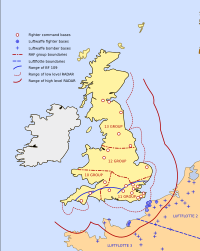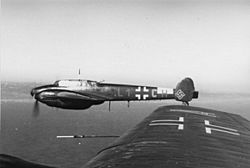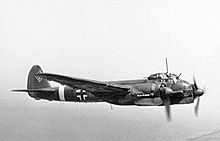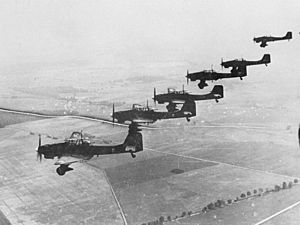Adlertag facts for kids
Quick facts for kids Adlertag |
|||||||
|---|---|---|---|---|---|---|---|
| Part of the Western Front of World War II | |||||||
 An air battle, 1940 |
|||||||
|
|||||||
| Belligerents | |||||||
| Commanders and leaders | |||||||
| Hugh Dowding Keith Park Charles Portal |
Hermann Göring Albert Kesselring Hugo Sperrle Joseph Schmid |
||||||
| Casualties and losses | |||||||
| Fighter Command: 13 fighters (air) 1 fighter (ground) 3 fighter pilots killed RAF Bomber Command: 11 bombers (air) 24 aircrew killed 9 captured Other: 47 miscellaneous aircraft (ground) c. 25 civilians killed |
47–48 aircraft destroyed (air) 39 severely damaged circa 200 killed or captured including: 44 killed 23 wounded at least 45 missing |
||||||
Adlertag (which means "Eagle Day" in German) was the first major attack of "Operation Eagle Attack" (Unternehmen Adlerangriff). This was a big plan by Nazi Germany's air force, the Luftwaffe, to destroy the British Royal Air Force (RAF). Germany wanted to invade Britain, but first, they needed to control the skies.
This operation happened during the Battle of Britain. The German leader, Adolf Hitler, ordered his military to get ready to invade Britain. This invasion was called Operation Sea Lion. But before any ships could cross the English Channel, the Luftwaffe had to defeat the RAF. This was to stop the RAF from attacking the invasion fleet or protecting the British navy.
Adlertag and the attacks that followed did not succeed in destroying the RAF or gaining control of the air. Because of this failure, Operation Sea Lion, the invasion of Britain, was put off forever.
Contents
Why it Happened
The Big Picture of the War
After Britain and France declared war on Germany in 1939, there was a quiet period on the Western Front. But in May 1940, Germany launched a huge attack on Western Europe. This attack, called "Operation Yellow," led to the defeat of the Allies and the fall of France. The British army managed to escape at Dunkirk, but Germany took over much of France. France surrendered in June 1940.
With most of Western Europe under German control, Hitler hoped Britain would agree to peace. But the British government, led by Winston Churchill, refused. So, Hitler ordered his air force and navy to prepare for an invasion of Britain, called Operation Sea Lion. The Luftwaffe's main job was to get rid of the RAF.
Early Air Battles
The Luftwaffe had lost many planes in earlier battles, so they had to wait to rebuild their strength before attacking the RAF directly. The first part of Germany's air attack happened over the English Channel from July to early August 1940. German planes attacked British ships, trying to draw out the RAF. These attacks didn't sink many ships, but they did help the Luftwaffe get ready for bigger battles.
In the next phase, from August 8 to 18, German planes attacked ships, airfields near the coast, and radar stations in southern England. The attacks became more frequent. On August 12, the Germans launched their first big raid inland against RAF airfields and radar stations. Some radar stations were damaged, but they were mostly working again by the next morning. The attacks on airfields also failed to destroy them. The Germans thought they were doing a lot of damage to the RAF, so they decided to launch their full attack the next day.
German Air Force Plans
Bad Information
One of the main reasons Adlertag failed was because of bad intelligence, meaning incorrect information. The British were getting better at gathering information, partly because they could decode German messages. This gave the British a good idea of where German forces were.
The head of the Luftwaffe's intelligence, Joseph Schmid, made many mistakes. He thought the Luftwaffe was much stronger than it was and underestimated the RAF. He also thought Britain could not build many new fighter planes, which was wrong. Most importantly, he didn't realize how important British radar was.
Radar stations along the coast gave early warnings of incoming German raids. This allowed the RAF to send their planes to the right places at the right time. The Luftwaffe also often attacked airfields that belonged to other RAF commands, like Coastal Command or Bomber Command, instead of the main Fighter Command bases. This meant that even if they destroyed these bases, it wouldn't hurt the RAF's ability to defend Britain.
Targets for Attack
The Germans chose many targets for August 13, 1940. These included RAF airfields like RAF Biggin Hill, RAF Kenley, RAF Hornchurch, and RAF Manston. They also targeted radar stations and ports like Portsmouth and Southampton. However, as mentioned, many of these targets were not key Fighter Command bases.
British Air Force Preparations
Finding the Enemy
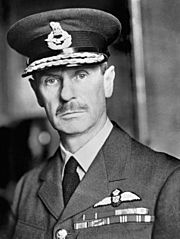
The British defense relied on a smart system of detection and control, known as the "Dowding System." It was named after Hugh Dowding, the commander of RAF Fighter Command. Dowding made sure the RAF used radar, which was called Radio Direction Finding (RDF) to keep it secret. This system, along with information from the Royal Observer Corps (ROC), was vital for the RAF to find and intercept German planes.
Radar stations along the British coast could often spot German planes forming up over France and Belgium. Once the German planes flew inland, the ROC would track them. All this information went to the main operations room at RAF Fighter Command Headquarters. Here, staff would figure out if the planes were "hostile" (enemy) or "friendly." If they were enemy planes, the information was sent to a large underground bunker called the "operations room."
Tracking the Raids
In the operations room, women from the Women's Auxiliary Air Force (WAAF) plotted the path of each raid on a large map. They used color-coded counters to show where the planes were, how high they were flying, and how many there were. This system allowed the main "Fighter Controller" and Dowding to see exactly where each German formation was going. This helped them guess what the targets might be. This simple system allowed them to make quick decisions.
Talking and Intercepting
This information was also sent to the headquarters of each RAF group. There, it was double-checked and sent to another operations room. The "Duty fighter controller" at each group decided how and when to send RAF planes to intercept the German raids. A good telephone system made sure information flowed constantly between airfields, the Observer Corps, and other military units.
The Battle Begins
KG 2's Early Attack
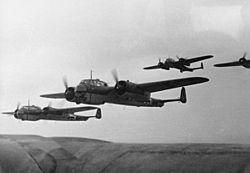
On the morning of August 13, the weather was bad, and the German commander, Hermann Göring, ordered a delay in the attacks. However, the Dornier Do 17 bombers of KG 2 did not get the message. They took off early, at 4:50 AM, heading for their target, Eastchurch airfield. Their fighter escorts, ZG 26, did receive the cancellation order and tried to warn the bombers, but couldn't reach them by radio. The bombers, led by Johannes Fink, continued their mission even without escorts.
Because of low clouds, the British Observer Corps and radar misjudged the direction of the bombers. This meant the RAF didn't send fighters to the right place, and KG 2 reached Eastchurch airfield. KG 2 claimed they destroyed 10 Spitfires on the ground, but in fact, no Fighter Command planes were lost. Eastchurch was a Coastal Command station, not a fighter base. The attack did damage the airfield's buildings and equipment, and 16 people were killed. But the airfield was back in action by 4:00 PM.
Eventually, RAF fighters did intercept the bombers. KG 2 lost five Do 17s, and six more were badly damaged. The German gunners on the bombers shot down two British Hurricanes.
Attacks on Coastal Airfields and Ports
Many German units received the order to cancel morning operations, but some still attacked airfields and ports in southern Britain. KG 76 attacked RAF Kenley and other airfields. KG 27 tried to bomb Bristol docks but lost a plane.
The cancellation order didn't reach Luftflotte 3 at all, so its commander, Hugo Sperrle, ordered attacks to begin. German Junkers Ju 88 bombers took off to hit airfields like 'RAF Farnborough' and RAF Odiham. Many Junkers Ju 87 dive bombers also headed for Portland Harbour. These raids had strong fighter escorts. RAF fighters intercepted them, and four Ju 88s and one Bf 109 were shot down. The Germans claimed many RAF fighters, but in reality, only three British fighters were lost.
Later, a group of Bf 110 fighters from V./LG 1 took off, possibly to draw out RAF fighters. But the bombers they were supposed to escort had their mission cancelled. The Bf 110s continued to Portland Harbour and ran into RAF Hurricanes. They lost six Bf 110s, while only one Hurricane was shot down. The morning's attacks were very messy for the Germans, showing problems with their communication.
More Attacks in the Afternoon
The main German attacks officially started at 2:00 PM. Around 3:30 PM, many Ju 88s from LG 1, with Bf 110 escorts, took off to bomb Boscombe Down and RAF Worthy Down. Other planes were sent to bomb RAF Andover and other airfields. German fighters flew ahead to try and clear the sky of RAF planes, but this only warned the British defenses earlier. When the main German wave arrived, 77 RAF fighters were waiting for them.
Some German dive bombers were badly hit by RAF planes, losing six out of nine Ju 87s in one attack. Many German units changed their targets because of clouds. For example, I./LG 1 bombed Southampton instead of Boscombe Down. They destroyed warehouses and a cold storage plant. The Luftwaffe didn't realize that the Spitfire factory in Southampton was a very important target.
Dive Bomber Operations
More Ju 87 dive bombers from StG 77, escorted by Bf 109s, also attacked. They were targeting RAF Warmwell but missed their target and dropped bombs randomly. Another group, Erprobungsgruppe 210, attacked targets near Southend, but found thick clouds and dropped their bombs over Canterbury instead.
IV./LG 1, also with Ju 87s, attacked RAF Detling. German fighters flew ahead to clear the skies. The Ju 87s bombed the station, and Bf 109s flew low, shooting at it. The station commander and other personnel were killed or wounded. Many British planes on the ground were destroyed. However, Detling was not an RAF Fighter Command station, so this attack didn't hurt the main British fighter defenses.
South East Raids
Other German bomber groups, like KG 55, attacked Heathrow Airport. KG 55 had suffered heavy losses the day before. In the afternoon, a large force of Do 17 bombers from KG 3, with many fighter escorts, headed for Eastchurch airfield and the Short Brothers factory at Rochester. They caused significant damage to the factory that built the Short Stirling heavy bomber. Several RAF squadrons intercepted them.
The British RAF Bomber Command also took part. Twelve Bristol Blenheim bombers were sent to attack a German airfield in Denmark. Only one bomber returned; the rest were shot down by anti-aircraft fire and fighters. Twenty-four airmen were killed, and nine were captured.
Night Raids
As night fell, German bombers continued their attacks. Nine He 111 bombers from Kampfgruppe 100 tried to bomb the Supermarine Spitfire factory at Castle Bromwich, Birmingham. Only four found their target, and the bombs didn't stop fighter production much. Another group of He 111s attacked the Short Brothers factory in Belfast, Northern Ireland, destroying five Short Stirling aircraft. Other German bombers attacked cities across Britain, including Glasgow, Bristol, Cardiff, Liverpool, and Edinburgh. They caused little damage, and it's not known if any German planes were lost during these night raids.
What Happened Next
Results of the Raids
The Germans kept attacking airfields in southeastern England. On August 12, they hit airfields in Kent, and on August 13, they focused on airfields south of London. But their attacks on Detling and Eastchurch were failures because these were Coastal Command stations, not Fighter Command bases. The Germans thought that if they knocked out the coastal airfields, the RAF would have to move to these other bases. But the earlier attacks hadn't knocked out the coastal airfields, and Adlertag failed to make Detling or Eastchurch unusable.
Exaggerated Claims
In air battles, both sides often claim to have shot down more enemy planes than they actually did. On August 13, 1940, the RAF claimed to have shot down 78 German aircraft. In reality, Germany lost 47-48 planes destroyed and 39 badly damaged. The Luftwaffe, on the other hand, claimed to have destroyed 70 British Hurricanes and Spitfires in the air, and another 18 Blenheim bombers. This was a huge exaggeration. They also claimed 84 RAF fighters on the ground. In reality, the RAF lost 13 fighters and 11 bombers in the air, and 47 aircraft of various types on the ground.
The Battle of Britain Continues
The failure of Adlertag didn't stop the Luftwaffe. They continued their attacks on RAF airfields throughout August and into September 1940. These battles involved many planes and heavy losses for both sides. The Luftwaffe never really had a clear plan to defeat RAF Fighter Command. They tried to destroy RAF bases, then switched to bombing cities by day and night. They also tried to hit different British industries at the same time, like aircraft factories, then ports. They even tried to destroy the morale of the British people.
The Luftwaffes failure to identify the radar chain and tell the difference between RAF fighter bases and other RAF bases hurt their ability to destroy the British air defenses. The Luftwaffe didn't understand how important British radar was. The British aircraft industry was able to replace lost planes, and pilots were replaced quickly enough to keep the RAF strong. This prevented the Germans from winning. Meanwhile, the RAF was able to make sure the Luftwaffes planes and aircrew numbers went down in August and September.
After failing to defeat the RAF, the Luftwaffe changed its strategy to "The Blitz," which was a bombing campaign against British cities. But just like their campaign against the RAF, the targets kept changing, and they didn't put continuous pressure on any one type of target. This lack of clear strategy meant the German air offensive over Britain was doomed to fail. The air campaign against Britain in 1940 and 1941 was a big failure for Germany. It meant the war would continue. The Battle of Britain ensured that the Western Allies had a safe base in Britain from which they could launch the invasion of Western Europe later in the war.
Images for kids
-
Hugo Sperrle, commanded Luftflotte 3.
See Also


